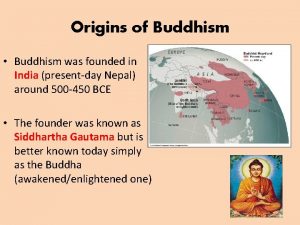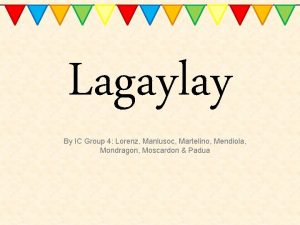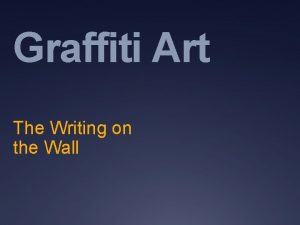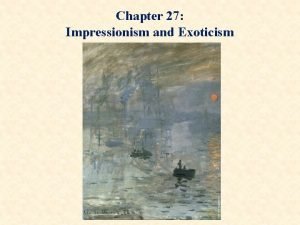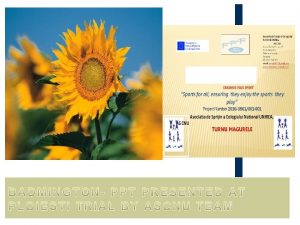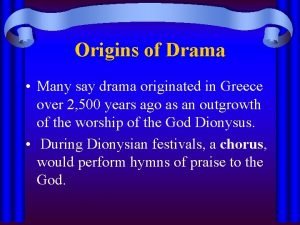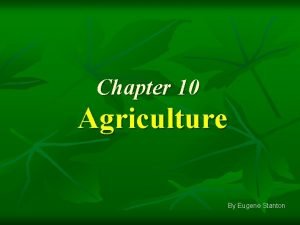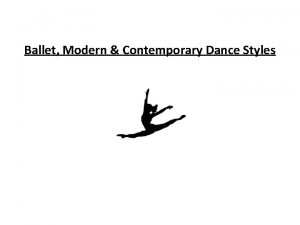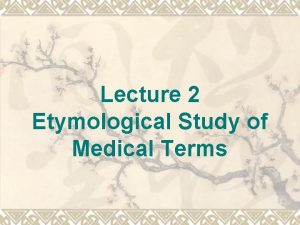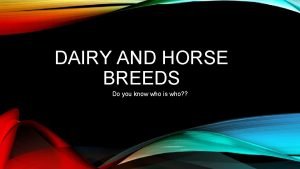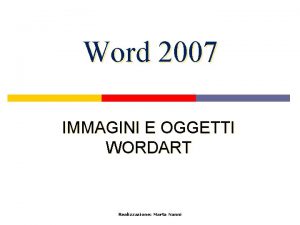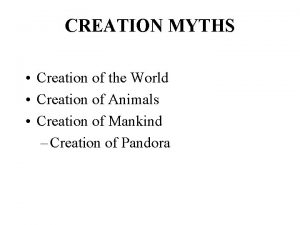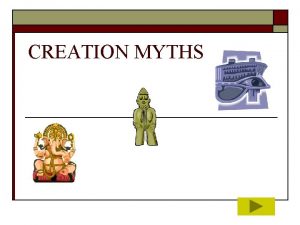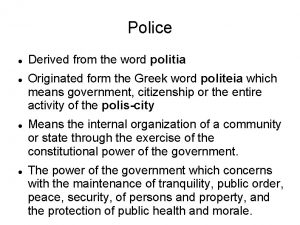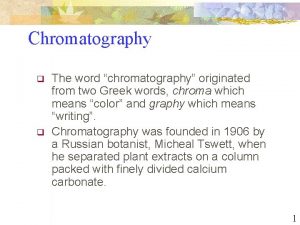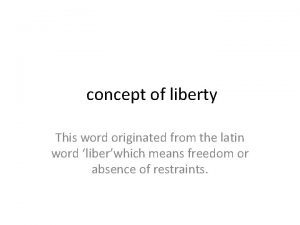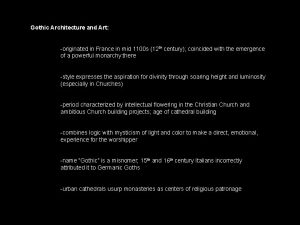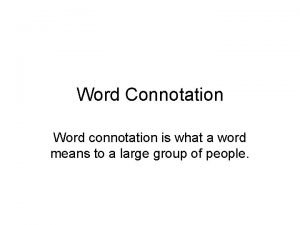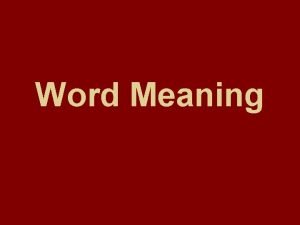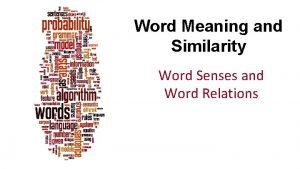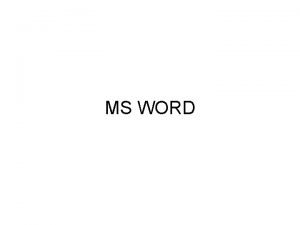Art as creation The word art originated from































- Slides: 31

Art as creation

• The word “art” originated from the Latin ars, which means “skill. ” It is equivalent to he Green techne, from which our modern word “technology” is derived. In the early days, the term was applied not only to craftsmanship but also to proficiency in performing any activitiy.

• Thus, medicine, agriculture and military expertise were considered arts. Now these skills have been grouped under the category of the practical sciences. Although “art” is still used to mean “proficiency”, as when we speak of the art of cooking and of the martial arts, the word is now commonly used to refer to skills and products which are primarily intended to delight the senses and produce a satisfying experience of the beautiful.

• While these works may also have other functions – a buidling serves a particular purpose: as a residence, a place of worship, or an office; and a stage play may have a religious or political intent – they are considered workds of art because they have aesthetic value.

Art is a planned activity.

• Unlike the spider when it weaves its web, the artist does not put his materials into shape instinctively. Rather, he thinks out a design, selects his materials, and arranges them according to his design. To be sure, he may not be wholly original; no artist really is. But he would be producing something that never existed before. Sometimes, the finished product may not turn out as he had originally envisioned it to be.

• Unlike the spider when it weaves its web, the artist does not put his materials into shape instinctively. Rather, he thinks out a design, selects his materials, and arranges them according to his design. To be sure, he may not be wholly original; no artist really is. But he would be producing something that never existed before. Sometimes, the finished product may not turn out as he had originally envisioned it to be.

Art and Experience

• At least three major kinds of experience are involved in the artistic activity. As we noted earlier, it usually starts as an • experience which the artist wants to communicate. Then the • act of expressing this experience – that of creating the art object or form – is itself another kind of experience. Finally, when the work is done, there is the artists’ • gratifying experience of having accomplished something significant.

• But there is still another kind of experience associated with art. This refers to what an onlooker or listener undergoes when he perceives the work of art. The perception may • kindle an experience which is similar or related to that which the artist tried to express.

• A landscape painting may recall happy childhood days spent in some such landscape; a song may bring back a pleasurable experience in the past associated with it.

• Thus, when one character has a tragic experience, we cry with pity for him, and we also feel fear and sorrow with him, because we virtually live the sme life he lives. Of course, when the lights are turned on at the end of the performance, we go back to our former selves, relieved to note that the experience was something we had only vicariously gone through.

Art as nature

Is nature an Art?

• Art is not nature. A distinction must be made between the two. The colorful sunset over Manila Bay, the sky full of stars on a summer evening, the sound of mayas singing in the field – these are natural things. They are not works of art.

• A work of art is man-made, and although it may closely resemble nature, it can never duplicate nature. • The closest that we can get to doing this is with a camera. • But even then, a photograph is only a record of the subject or the scene.

Art and Beauty

The desire for beauty and order around us is another basic human need. Somehow these provide the much needed comfort and balance to our lives. We may find beauty in nature, as in the loveliness of a volcano rising majestically to the skies, or of a slender waterfall that looks like a bridal veil from a distance. Or we may find it in manmade objects like an impressive bridge, a ceramic vase, or even in a tender love song

A thing of beauty is one which gives us pleasure when we perceive it. The delight that we experience is called aesthetic pleasure, “aesthetic” coming from a Greek word which means “to perceive with senses. ”

• What we call beauty is relative, however. • What may be beautiful to us may not be so to others. And no two persons would derive exactly the same degree of satisfaction from seeing what they mutually agree upon as a beautiful object or from listening to what they both consider a beautiful tune. • Our attitude is usually conditioned by many factors, among which are our social involvement, our education and training

An artist’s own concept may change as he grows older. This accounts for differences in an artist’s own style and expression.

Concepts of beauty vary between cultures too. That is why the Western listener finds it difficult to appreciate Asian music, just as we in our time, with our ears attuned to music in the Western tradition, find little pleasure in listening to the music of our ethnic group.

The Subject of Art

The Subject of Art • The subject of art is varied. It may refer to any person, object, scene, or even represented in a work of art. • Representational Art – Arts that have subjects e. g. , painting, sculpture, graphic arts, literature, theatre and others. Non-Representational Art – Arts that do not have subjects, e. g. , music, architecture, and many functional arts. – Do not present descriptions, stories or references to identifiable objects or symbols. – They appeal directly to the senses primarily because of the satisfying organization of their expressive elements. •

Ways of Presenting the Subject • Realism – the objects are depicted in the way they would normally appear in nature. • Abstraction – does not show the subject at all as an objective reality but only an idea of it or the feeling about it. – A technique of simplifying and reorganizing objects and elements according to the artist’s creative expressions. – The original objects have been reduced to simple geometric shapes and they can be rarely identified unless the artist named them in his/her title.

Abstraction does not show the subject at all as an objective reality but only an idea of it or the feeling about it. A technique of simplifying and reorganizing objects and elements according to the artist’s creative expressions. The original objects have been reduced to simple geometric shapes and they can be rarely identified unless the artist named them in his/her title.

Ways of Presenting the Subject • Distortion – A technique employed by the artist to dramatize the shape of a figure in order to create an emotional effect. – Twisting, stretching, or deforming the natural form and shape of the object, e. g. , caricatures. Distorted Faces 03 124 K (1 Today) BY Doryfoo |

Kinds of Subjects 1. Landscapes, seascapes and cityscapes. 2. Still Life 3. Animals 4. Portraits 5. Figures 6. Everyday Life 7. History and Legend 8. Religion and mythology 9. Dreams and fantasies

Assignment There are 9 Kinds of Subjects and 3 Ways of Representation. Your assignment is to give 3 examples for each of the 9 kinds of subjects. The examples are in the form of images of paintings downloaded from the Internet. The examples should include all the 3 ways of representation. So the 1 st example is realism, 2 nd abstraction and 3 rd distortion. I have downloaded a sample format in our files. Include the title and artist of your examples. Submission is still through Assigments like your first assignment. (online and text format). Kinds of subject 1. 2. 3. 4. 5. 6. 7. 8. realism abstraction distortion


• Thank you so much. • Any questions?
 The word audit originated from the latin word
The word audit originated from the latin word Potential nursing diagnosis
Potential nursing diagnosis Where is islam originated
Where is islam originated Where in india was buddhism founded
Where in india was buddhism founded Rock latino instruments
Rock latino instruments Hermana mayora
Hermana mayora Lagaylay
Lagaylay Where was graffiti originated
Where was graffiti originated Where did french cuisine originated
Where did french cuisine originated Antiromanticism
Antiromanticism The scandal known as watergate originated from the
The scandal known as watergate originated from the Badminton rules serve
Badminton rules serve Where do vikings come from
Where do vikings come from When was drama originated
When was drama originated Vegetative planting probably originated in
Vegetative planting probably originated in History of line dance
History of line dance What country did impressionism originated from
What country did impressionism originated from What is a pageant wagon
What is a pageant wagon Sikhism origins
Sikhism origins Direct method in teaching grammar
Direct method in teaching grammar Where did contemporary dance originated
Where did contemporary dance originated The modern mother's day celebration originated from
The modern mother's day celebration originated from Vantacid
Vantacid Macbeth map
Macbeth map This breed originated in french alps
This breed originated in french alps Word 2007 word art
Word 2007 word art Capolettera word
Capolettera word Hình ảnh bộ gõ cơ thể búng tay
Hình ảnh bộ gõ cơ thể búng tay Slidetodoc
Slidetodoc Bổ thể
Bổ thể Tỉ lệ cơ thể trẻ em
Tỉ lệ cơ thể trẻ em Gấu đi như thế nào
Gấu đi như thế nào



